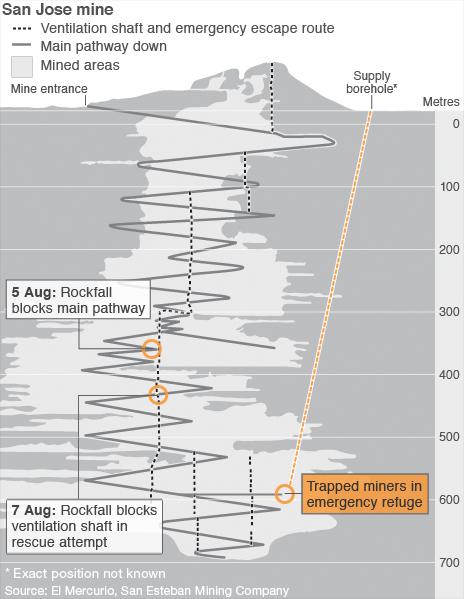Trapped Chile miners get supplies
- Published
Mining Minister Laurence Golborne: "We are sending you water"
Thirty-three miners trapped underground in Chile since 5 August have begun receiving glucose, rehydration tablets and medicine.
Capsules containing the supplies were sent down a tube, which is the miners' only lifeline.
Rescuers made contact with the men on Sunday after lowering a probe some 700m (2,300ft) beneath the surface.
The miners have not been told it may take up to four months to get them out, the head of the rescue operation said.
Andres Sougarret said it could take that long to drill a new shaft wide enough to pull the men to safety.
Specialised equipment has begun to arrive at the San Jose copper and gold mine, near the city of Copiapo, for the task.
Medical histories
Engineers also opened lines of communication to talk to the men.
"They asked for food, and toothbrushes and something for their eyes," said Mining Minister Laurence Golbourne.
Glucose solutions, rehydration tablets and medicine have been sent down to the miners, and these were to be followed by high-protein, high-calorie foods similar to those designed for astronauts, officials said.
The miners are also being asked to detail their medical histories to get a better idea of the group.
People across Chile celebrated on Sunday night, waving flags and sounding the horns of their cars, when news emerged that the trapped miners had been contacted.
The miners have been trapped since 5 August, when the main access tunnel collapsed. They are located some 700m vertically underground, 7km (4.5 miles) inside the winding mine.
They took refuge in a 50 sq m shelter, although some experts and workers familiar with the mine said the men had about 1.8km (1.1 miles) of space to move around in, AFP news agency reported.
Tanks of water inside, along with water from drilling machines and ventilation shafts helped the men to survive.
'Umbilical cord'
The miners say that they survived on cans of tuna, milk and biscuits which were stored in the shelter.
"They had two little spoonfuls of tuna, a sip of milk and a biscuit every 48 hours," said Sergio Aguila, a doctor who is part of the rescue team.
Mr Sougarret has said he is examining where to drill a hole big enough to extract the miners.
"The umbilical cord is ready. Now comes the engineering design, the topography, and then begins the work of drilling," he told AFP.
Rescuers aim to drill a 66cm-wide hole to bring the men to the surface one by one.
